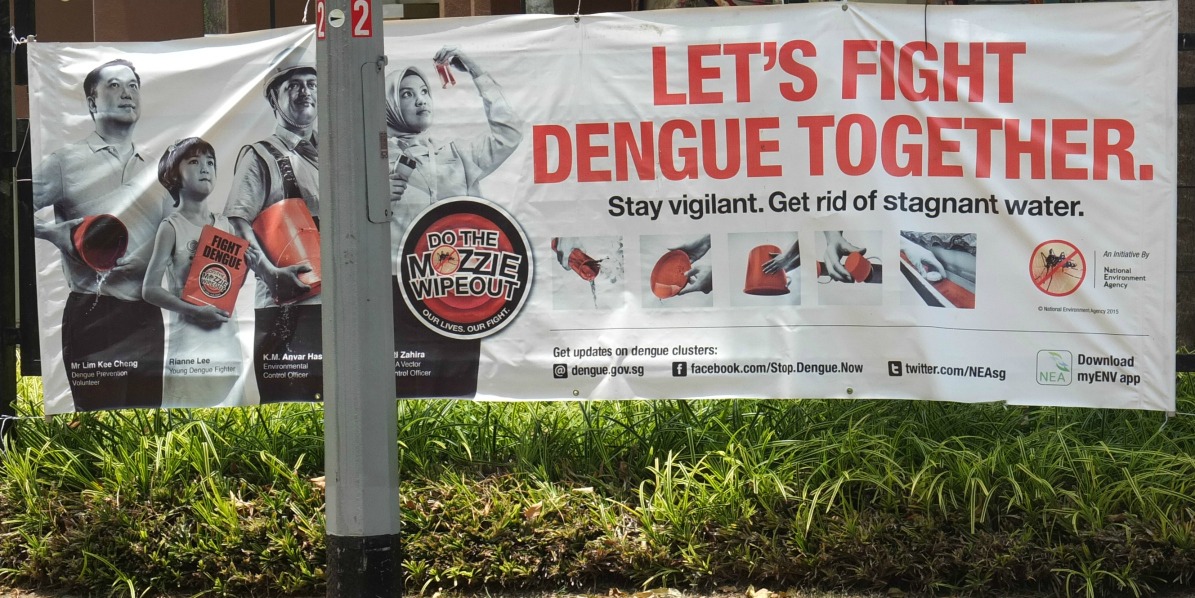
There is currently an outbreak of dengue in Singapore, where Imke, one of our writers, recently spotted this poster. As well as transmitting the Zika virus, Aedes mosquitoes also transmit the viruses that cause dengue. In this latest article in our series on infectious diseases, we have put together a German-English glossary of terms relating to dengue.
The dengue virus
Dengue is caused by four related virus strains called serotypes, known as DEN-1, DEN-2, DEN-3 and DEN-4. According to the World Health Organization (WHO), it is widespread throughout the tropics and leads to an estimated 390 million infections each year. It is transmitted by female mosquitoes who have bitten infected humans. After an incubation period of four to ten days, an infected mosquito can transmit the virus for the rest of its life.
| German | English |
| Dengue-Fieber/Denguefieber (n.) | Dengue, also: dengue fever |
| Dengue-Virus (n.) | dengue virus |
| Inkubationszeit (f.) | incubation period |
| Serotyp (m.) | serotype |
Dengue symptoms and diagnosis
Unlike malaria, dengue and Zika are both transmitted by mosquitoes that are most active during the day (Aedes aegypti and Aedes albopictus). The incubation period is four to ten days after being bitten by an infected mosquito.
A high fever, which may be biphasic (with two peaks), is common in all four dengue subtypes. The sudden onset of fever (40° C/104° F) in dengue is accompanied by severe headache, muscle and joint pain, nausea, vomiting, swollen glands and generalised rash. The combination of fever, rash and headache is known as the ‘dengue triad’. Pain behind the eyes is another classic symptom, along with severe pain in the bones, joints and muscles that give the disease its nickname of ‘break-bone fever’.
The fever reduces below 38 °C/100 °F) after three to seven days. Warning signs and symptoms at this stage include severe abdominal pain, persistent vomiting, blood in the vomit, rapid breathing, bleeding gums, lethargy and restlessness.
These signs are indications of a serious form of the disease known as severe dengue or dengue haemorrhagic fever (DHF), which is accompanied by bleeding in the gastrointestinal tract. Dengue shock syndrome (DSS) is another form of severe dengue with DHF signs plus circulatory failure. The risk of severe disease is higher in new or parallel infection with another dengue subtype, which can be particularly life-threatening for children.
| German | English |
| Bauchschmerzen (pl.) | abdominal pain (sing.) |
| Dengue mit schwerer Verlaufsform | severe dengue |
| Dengue-Schocksyndrom (DSS) | dengue shock syndrome (DSS) |
| Dengue-Triade | dengue triad |
| Drüsenschwellung (f.) | swollen glands; lymphadenopathy |
| Fieber (n.) | fever |
| Hämorrhagisches Dengue-Fieber (n.); DHS | dengue haemorrhagic fever (DHF) |
| Hautausschlag (m.) | rash |
| Knochenbrecherfieber (n.) | break-bone fever |
| Moskitostich; Mückenstich (m.) | mosquito bite |
| Zahnfleischbluten (n.) | bleeding gums, gingival bleeding |
You can find more terminology relating to viral infections in our German-English glossaries of Zika virus terms and flu terms.
Treatment for dengue
Treatment for dengue depends on the symptoms. Aspirin is contraindicated due to the risk of internal bleeding. Travellers should not take aspirin for headache or flu-like symptoms in tropical areas where dengue fever is endemic or where there has been a recent outbreak. This also applies to travellers returning from these areas.
Dengue haemorrhagic fever and dengue shock syndrome are life-threatening forms of the disease. Without intensive care and compensation of fluid loss in particular, the mortality rate of DHF is 20%. Even with adequate treatment, 1–2.5% of hospitalised patients die.
| German | English |
| fieberhafte Erkrankung (f.) | febrile illness |
| grippeartige Symptome (pl.) | flu-like symptoms |
| intensivmedizinische Behandlung (f.) | intensive care/intensive care treatment |
| Mortalität (f.) | mortality |
Prevention of dengue
Dengue viruses are most commonly transmitted by Aedes aegypti mosquitos, which are most active in the early morning and just before dusk. Aedes albopictus can also transmit dengue viruses. The best prevention is elimination of mosquitoes (by removing breeding sites) and protecting yourself from mosquito bites. Use mosquito nets and/or screens, wear long-sleeved, light-coloured clothing that is not too tight, and use insect repellents containing active ingredients such as DEET or icaridin.
There are a number of factors to consider when choosing an appropriate repellent, especially for children and pregnant women. DEET provides long-lasting protection but it can damage plastics such as smartphones, sunglasses or water bottles.
Humans are the main carriers of dengue viruses. Major epidemics occur every three to five years in affected areas, usually during or after the rainy season. The high number of carriers increases the risk of infection at these times.
A dengue vaccine has recently been approved in Mexico, the Philippines and Brazil, and is currently awaiting approval in Thailand.
| German | English |
| Hauptwirt (m.) | main carrier |
| Impfung (f.) | vaccination |
| Repellentien (pl.) | repellents |
| Stechmücke (f.) | mosquito |
| Übertragung (f.) | transmission |
Other articles in this series
This article is part of a series of German-English glossaries on infectious diseases. Have a look at the other articles in the series:
- Glossary of Zika virus terms in German and English
- Glossary of influenza terms in German and English
- Dengue: a glossary of terms in German and English
References and further information
In English:
http://www.cdc.gov/dengue/resources/30Jan2012/aegyptifactsheet.pdf
http://ecdc.europa.eu/en/healthtopics/dengue_fever/Pages/index.aspx
http://www.who.int/mediacentre/factsheets/fs117/en/
http://www.who.int/topics/dengue/en/
http://emedicine.medscape.com/article/215840-clinical
http://patient.info/doctor/dengue-fever-pro
http://www.healthline.com/health/dengue-hemorrhagic-fever
http://www.cdc.gov/dengue/clinicalLab/caseDef.html
http://wwwnc.cdc.gov/travel/diseases/dengue
http://www.nhs.uk/Conditions/dengue/Pages/Introduction.aspx
http://www.hhmi.org/biointeractive/dengue-virus-life-cycle
http://www.reuters.com/article/us-asia-dengue-vaccine-idUSKCN0US1IB20160114
In German:
http://www.tropeninstitut.at/denguefieber.htm
http://tropeninstitut.de/reiseziel/laenderinfo.php?lid=153
http://dgk.de/gesundheit/impfen-infektionskrankheiten/krankheiten-von-a-bis-z/dengue-fieber.html
Description with map of endemic risk areas:
http://www.reisemed.at/krankheiten/dengue-fieber
Robert Koch Institute – Specialist dictionary of infection control and infectious disease epidemiology, 2015, available as a PDF or print edition:
http://www.rki.de/DE/Content/Service/Publikationen/Fachwoerterbuch_Infektionsschutz.html
Robert Koch Institute –Epidemiological Infection Yearbook for 2014:
http://www.rki.de/DE/Content/Infekt/Jahrbuch/Jahrbuecher/2014.html?nn=2374622
Robert Koch Institute – Rare and imported infectious diseases (RKI Guide, 2011; PDF, 187 pages):
http://www.rki.de/DE/Content/InfAZ/Steckbriefe/Steckbriefe_120606.pdf?__blob=publicationFile
Centre for Travel Medicine http://www.crm.de (website provided by the Thieme publishing group):
Case definitions for notifiable diseases:
http://www.rki.de/DE/Content/Infekt/IfSG/Falldefinition/falldefinition_node.html
More on repellents and possible adverse effects:
http://www.pharmazeutische-zeitung.de/index.php?id=1640
Vaccination:
http://www.pharmazeutische-zeitung.de/index.php?id=52098
http://der-farang.com/de/pages/impfstoff-gegen-denguefieber-1
Original article by Imke Brodersen, English-German medical translator. English glossary terms and references by Jayne Fox. Translated into English by Jayne Fox, German-English medical translator and editor. I’d love to hear your thoughts on this article. Head over to Google+ or Twitter to continue the conversation!


